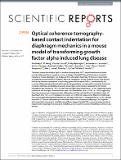Optical coherence tomography-based contact indentation for diaphragm mechanics in a mouse model of transforming growth factor alpha induced lung disease
Abstract
This study tested the utility of optical coherence tomography (OCT)-based indentation to assess mechanical properties of respiratory tissues in disease. Using OCT-based indentation, the elastic modulus of mouse diaphragm was measured from changes in diaphragm thickness in response to an applied force provided by an indenter. We used a transgenic mouse model of chronic lung disease induced by the overexpression of transforming growth factor-alpha (TGF-α), established by the presence of pleural and peribronchial fibrosis and impaired lung mechanics determined by the forced oscillation technique and plethysmography. Diaphragm elastic modulus assessed by OCT-based indentation was reduced by TGF-α at both left and right lateral locations (p < 0.05). Diaphragm elastic modulus at left and right lateral locations were correlated within mice (r = 0.67, p < 0.01) suggesting that measurements were representative of tissue beyond the indenter field. Co-localised images of diaphragm after TGF-α overexpression revealed a layered fibrotic appearance. Maximum diaphragm force in conventional organ bath studies was also reduced by TGF-α overexpression (p < 0.01). Results show that OCT-based indentation provided clear delineation of diseased diaphragm, and together with organ bath assessment, provides new evidence suggesting that TGF-α overexpression produces impairment in diaphragm function and, therefore, an increase in the work of breathing in chronic lung disease.
Citation
Wang , K C W , Astell , C J , Wijesinghe , P , Larcombe , A N , Pinniger , G J , Zosky , G R , Kennedy , B F , Berry , L J , Sampson , D D , James , A L , Le Cras , T D & Noble , P B 2017 , ' Optical coherence tomography-based contact indentation for diaphragm mechanics in a mouse model of transforming growth factor alpha induced lung disease ' , Scientific Reports , vol. 7 , 1517 . https://doi.org/10.1038/s41598-017-01431-x
Publication
Scientific Reports
Status
Peer reviewed
ISSN
2045-2322Type
Journal article
Description
Funding provided by the National Health and Medical Research Council (NHMRC) of Australia (1027218). P.N. and K.W. are supported by NHMRC Fellowships (1045824, 1090888). P.W. was supported by the William and Marlene Schrader Postgraduate Scholarship, The University of Western Australia, and C.A. by an NHMRC Preterm Infants CRE top-up scholarship.Collections
Items in the St Andrews Research Repository are protected by copyright, with all rights reserved, unless otherwise indicated.

